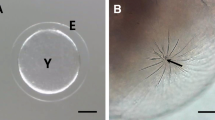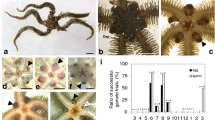Summary
The ready egg shell of Larus argentatus was studied, in particular concerning structure and optical behaviour of the “colour bands“, i.e. the traces of the protoporphyrin spots in the transverse ground section. The bands are characterized by optically isotropic porphyringranules enclosed in the calcite, whilst the globular inclusions here fail. On the exterior border of the ground section one can find occasionally no calcified pigment material. Microphotogramms in incident and transmitted light were given from the out- and (after removal the membrane) from the inside (“mammillary relievo”) of the shell. In the egg shell of Larus neighboured “cones” often grow together also in their basal part, wherewith the intermammillar spaces disappear — as presented on transverse ground section and on mammillar relievo.
Three developmental stades from Larus canus egg shells were observed. In the youngest and also in the middle the spheritic elements are still separated, in the oldest fused; but even in the last the calcite shell has not reached the full thicknes. In the first stade the eisospherite and, from the exospherite, the basal part of the cone, free from inclusions, was developed. In the second stade the developing cone was limited by a dome shaped exterior face. In the third stade also the distal part of cone, rich on inclusions was finished and the shell surface leveled; a first colour band appeared and the commencement of pore canals was visible.
Zusammenfassung
Bei Larus argentatus wurde die fertige Eischale untersucht, insbesondere hinsichtlich Struktur und optischen Verhaltens der „Farbbänder“, d.h. der Durchschnitte der Protoporphyrinflecken am Querschliff: ihrem Calcit sind isotrope Porphyringranula eingelagert, während die kugeligen Gasinklusionen hier fehlen. Am Außenrand des Querschliffes kann Farbstoffmaterial gelegentlich auch unverkalkt auftreten. Außen- und (nach Entfernung der Membran) Innenfläche („Mammillenrelief“) der Kalkschale wurden im Auf- und im Durchlicht dargestellt. Nicht selten verwachsen bei Larus benachbarte „Kegel“ auch in ihrem basalen Teil, womit das intermammillare Furchensystem verschwindet — was am Querschliff und am Mammillenrelief vorgeführt wird.
Von Larus canus lagen 3 Entwicklungszustände der Schale vor. Beim jüngsten und ebenso beim mittleren waren die sphäritischen Elemente noch getrennt, bei dem ältesten aber verwachsen, jedoch hatte auch dann die Kalkschale ihre volle Dicke noch nicht erreicht. Das erste Stadium zeigte den Eisosphäriten und vom Exosphäriten den basalen einschlußfreien Teil des Kegels. Im zweiten Stadium schloß die Kegelanlage mit kuppeliger Außenfläche ab; im dritten hatte sich auch der distale, an Inklusionen reiche Teil des Kegels entwickelt und die Schalenoberfläche war eingeebnet; weiter konnten ein erstes Farbband und die Anfänge der Porenkanäle beobachtet werden.
Similar content being viewed by others
Literatur
Schmidt, W. J.: Beiträge zur mikroskopischen Kenntnis der Farbstoffe in der Kalkschale des Vogeleies. Z. Zellforsch. 44, 413–426 (1956).
—: Über die Farbbänder in der Kalkschale der Eier von Tetrapteryx, Larus und Gavia. S.-B. Ges. naturforsch. Freunde Berlin, N. F. 3, 129–143 (1963).
—: Das „Fischgrätenmuster“ auf dem Querschliff der kalkigen Eischale von Vögeln. Z. Zellforsch. 62, 53–60 (1964a).
—: Nochmals über die Primärsphäriten der Hühner-Eischale. Z. Zellforsch. 63, 682–685 (1964b).
—: Bemerkungen zur Entwicklung der Schale des Amsel-Eies. Z. Zellforsch. 65, 622–626 (1965a).
Schmidt W. J.: Die organischen Kerne der Mammillen in den Frühstadien der Eischalenbildung bei der Lachmöve. Z. Zellforsch. 65, 713–718 (1965b).
—: Die Eisosphäriten (Basalkalotten) der Schwanen-Eischale. Z. Zellforsch. 67, 151–164 (1965c).
—: Das organische Fachwerk in „Kegeln“ und „Kalotten“ der Vogel-Eischale. Z. Zellforsch. 68, 194–204 (1965d).
—: Einfache Verfahren zur Darstellung des Mammillenreliefs von Vogel-Eischalen. Z. wiss. Mikr. 67, 114–121 (1966a).
—: Das Verwachsen der Calcosphäriten bei der Schalenbildung des Vogel-Eies. Z. Morph. u. Ökol. Tiere 56, 252–258 (1966b).
Terepka, A. R.: Structure and calcification in avian eggshell. Exp. Cell. Res. 30, 171–182 (1963a).
—: Organic — inorganic interrelationsship in avian eggshell. Exp. Cell Res. 30, 183–192 (1963b).
Tixier, R.: Étude de l'ester méthylique de la biliverdine II Contribution à l'étude de l'ester méthylique de la biliverdine de coquilles d'Emeu. Bull. Soc. Chim. biol. (Paris) 27, 627–631 (1945).
Tyler, C.: Wilhelm von Nathusius 1821–1899. On avian eggshells. A translated and edited version of his work. University Reading 1964.
Völker, O.: Die Verbreitung von Protoporphyrin in Vogeleischalen. J. Ornithol. 88, 604–612 (1940).
Author information
Authors and Affiliations
Rights and permissions
About this article
Cite this article
Schmidt, W.J. Bau und Entwicklung der Möwen-Eischale. Zeitschrift für Zellforschung 71, 455–468 (1966). https://doi.org/10.1007/BF00349607
Received:
Issue Date:
DOI: https://doi.org/10.1007/BF00349607




